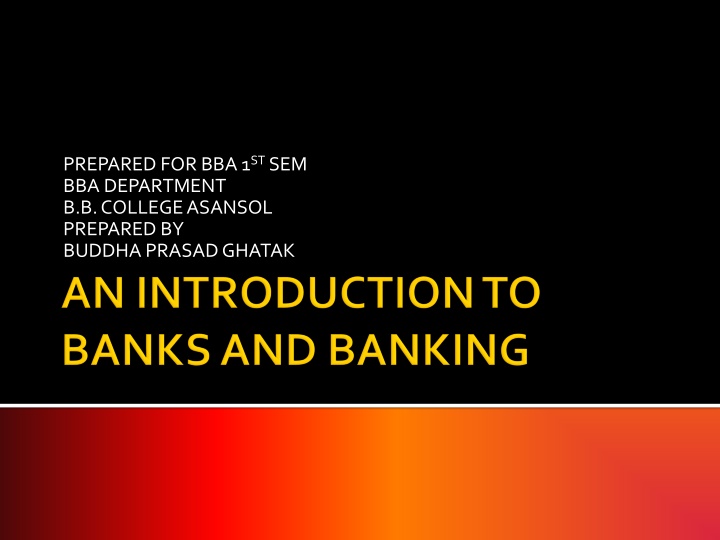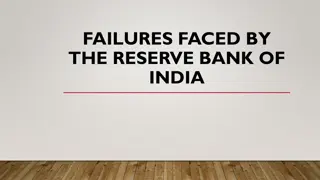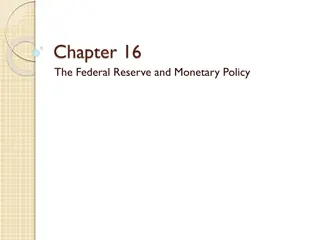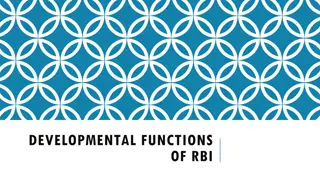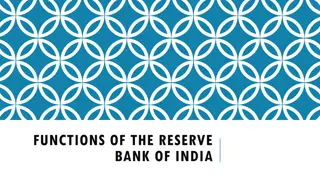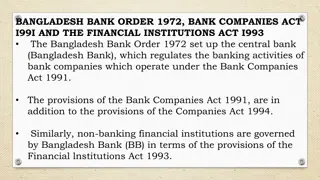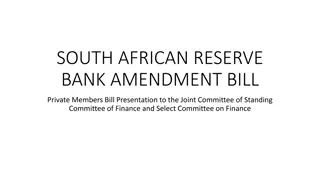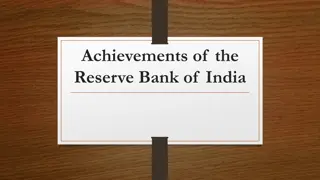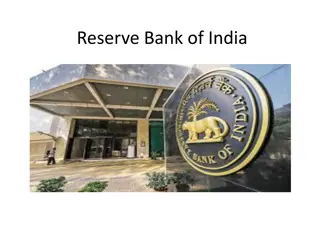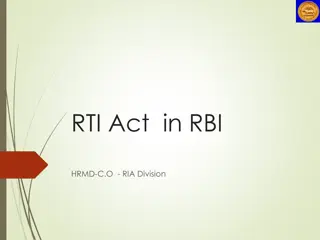Evolution of Reserve Bank of India: A Historical Overview
The Reserve Bank of India, established in 1935 and headquartered in Mumbai since 1937, has played a crucial role in India's financial landscape. From nationalization in 1949 to financial reforms in 2000, this summary covers key milestones in RBI's history, including regulatory expansions, nationalization of banks, market reforms, and strategic shifts in monetary policy.
Download Presentation

Please find below an Image/Link to download the presentation.
The content on the website is provided AS IS for your information and personal use only. It may not be sold, licensed, or shared on other websites without obtaining consent from the author.If you encounter any issues during the download, it is possible that the publisher has removed the file from their server.
You are allowed to download the files provided on this website for personal or commercial use, subject to the condition that they are used lawfully. All files are the property of their respective owners.
The content on the website is provided AS IS for your information and personal use only. It may not be sold, licensed, or shared on other websites without obtaining consent from the author.
E N D
Presentation Transcript
PREPARED FOR BBA 1STSEM BBA DEPARTMENT B.B. COLLEGE ASANSOL PREPARED BY BUDDHA PRASAD GHATAK
An establishment authorized by a government to accept deposits, pay interest, clear checks, make loans, act as an intermediary in financial transactions, and provide other financial services to its customers
CENTRAL BANK RESERVE BANK OF INDIA The Central Bank of our country is the Reserve Bank of India or RBI. The central office of the Reserve Bank was initially established in Calcutta but was permanently moved in Mumbai in the year 1937 In the year 1935, it came into existence, In the year 1949 RBI was nationalized and banking regulation Act was enacted. In the year 1950, India embarked on planned economic development and the Reserve Bank of India became active agent and participant.
In the Year 1966, cooperative banks came under RBI regulations. In the year 1969, 14 major commercial banks were nationalized. In the year 1973, RBI strengthened exchange control by amending Foreign Exchange Regulation Act or FERA. In the year 1974, priority sector lending targets were introduced. In the year 1975, Regional Rural Banks were set up. In the year 1980, six major commercial banks were nationalized.
In the year 1985, financial market reforms began with Sukhamoy Chakravartyand VaghulCommittee Reports. But, in the year 1991 India faced a balance of payment crisis and it pledged Gold to shore up reserves. Rupee was also devalued during this year. In the year 1993, exchange rate became market determined and in the year 1994 board for financial supervision was set up. In the year 1997, Ad hoc treasury bills phased out ending automatic monetization and regulation of non-banking finance company was strengthened. In the year 1998, multiple indicator approach for monetary policy was adapted. In the year 2000, Foreign Exchange management Act replaced FERA.
In the year 2002, Clearing Corporation of India Limited or CCIL commenced clearing and settlement in government securities. In the year 2003, fiscal responsibility and budget management Act was enacted. In the year 2004, transition to a full-fledged daily Liquidity Adjustment Facility or LAF was completed and Market Stabilizations Scheme or MSS was introduced to sterilize capital flows. Also real time gross settlement system was commenced in this year. In the year 2005, RBI focused on financial inclusion and increasing the outreach of the banking sector In the year 2006, RBI empowered to regulate money, forex, G-sec and gold related securities market. In the year 2007 RBI empowered to regulated payment system. In the year 2008 and 2009 proactive efforts were made by RBI to minimize impacts of global financial crisis.
To manage the monetary and credit system of India. To stabilize internal and external value of rupee. To balance and systematically develop the banking sector in India To develop organized money market in India To properly arrange for agricultural and industrial finance. To manage public debt. To establish monetary relations with other countries and international financial institutions.
To centralize cash reserves of commercial banks. To maintain balance between the demand and supply of currency. The objective of RBI is to ensure stability of interest and exchange rates to provide liquidity and an adequate supply of currency and credit for real sector. To ensure bank penetration and safety of depositors fund. To promote and develop financial institutions and markets in India. To play a crucial role in growth of Indian economy.
A commercial bank is a type of financial institution that accepts deposits, offers checking account services, makes various loans, and offers basic financial products likecertificates of deposits(CDs) and savings accounts to individuals and small businesses.
STATE BANK OF INDIA BANK OF BARODA UNITED BANK OF INDIA PNB BANK OF INDIA ETC.
AXIS ICICI HDFC YES BANDHAN JANA SMALL FINANCE ETC.
SIDBI NABARD EXIM ETC.
Primary functions: A. Accepting deposits The most important activity of a commercial bank is to mobilise deposits from the public. People who have surplus income and savings find it convenient to deposit the amounts with banks. Depending upon the nature of deposits, funds deposited with bank also earn interest. Thus, deposits with the bank grow along with the interest earned. If the rate of interest is higher, public are motivated to deposit more funds with the bank. There is also safety of funds deposited with the bank. 1.
B. Grant of loans and advances The second important function of a commercial bank is to grant loans and advances. Such loans and advances are given to members of the public and to the business community at a higher rate of interest than allowed by banks on various deposit accounts. The rate of interest charged on loans and advances varies depending upon the purpose, period and the mode of repayment. The difference between the rate of interest allowed on deposits and the rate charged on the Loans is the main source of a bank s income.
2. Secondary functions Besides the primary functions of accepting deposits and lending money, banks perform a number of other functions which are called secondary functions. These are as follows Issuing letters of credit, travellerscheques, circular notes etc. Undertaking safe custody of valuables, important documents, and securities by providing safe deposit vaults or lockers;
Providing customers with facilities of foreign exchange. Transferring money from one place to another; and from one branch to another branch of the bank. Standing guarantee on behalf of its customers, for making payments for purchase of goods, machinery, vehicles etc
Collecting and supplying business information; Issuing demand drafts and pay orders; and, Providing reports on the credit worthiness of customers.
RUNS ON COOPERATIVE BASIS GIVING CREDIT TO THE FARMERS GIVING LOAN TO THE COOPERATIVE MEMBERS.
